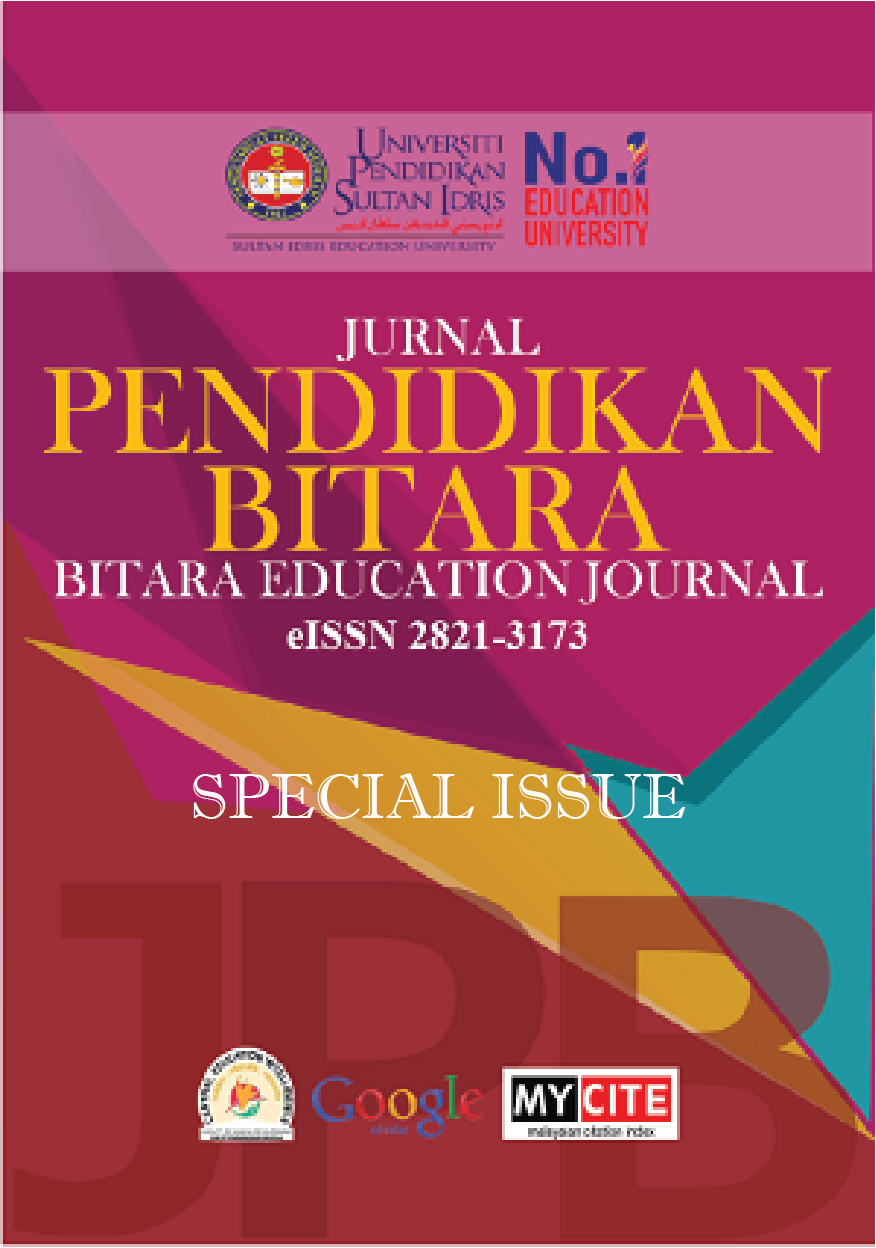Teacher needs for implementation of special needs early childhood intervention program
DOI:
https://doi.org/10.37134/bitara.vol12.sp.5.2019Keywords:
Teacher Needs, Special Needs Early Childhood Intervention ProgramAbstract
Special needs pupils are the human capital that needs to be given attention so that they are able to live independently and improve their self-reliance towards a successful career while contributing to the nation's development. The 21st Century skills are aimed at producing students who can compete globally. Therefore, this study was conducted to identify teachers' need for early intervention programs in special education preschools. The design of this study used a quantitative approach through the survey method using questionnaire instruments to obtain data. A total of 161 special education preschool teachers were selected through simple random sampling to answer the questionnaire. Aspects of teacher needs include training, collaboration, infrastructure and monitoring. While the implementation of early intervention involves aspects of planning and implementation. Instructors' needs were modified from the Malaysian Teacher's Standard instrument while the instrumentation of the initial intervention program was developed by the researchers based on the literature review appropriate to the scope of the study. Overall, the level of teacher needs in terms of training, collaboration, infrastructure, monitoring and teacher perspective in terms of planning and implementation are high. Kruskal Wallis analysis showed that there was a significant difference in teacher needs based on academic approval whereas in the overall MANOVA analysis, there were differences in teacher needs based on location. The implications of this study are that in order to achieve effective early intervention quality, the needs of teachers in terms of training, collaboration, infrastructure and monitoring should be given due attention.
Downloads
References
Al-Zoubi S, Bani Abdel Rahman M, Ismail H (2010). The Effect of in-Service Training Program in Improving Performance Competencies for Learning Disabilities Resource Room Teachers in Jordan. Educators Digest. 10: 4-11.
Avalos, B. (2011). Teacher Profesional Development in Teaching and Teacher Education Over Ten Years. Teaching and Teacher Education. 27: 10-20.
Begum Khalid & Mohd Hanafi Yasin. (2013). Best practices for parent involvement in school special education program learning disabilities from the teacher's perspective (Doctoral dissertation, SME).
Booth, C. L., & Kelly, J. F. (2012). Child care effects on the development of toddlers with special needs. Early Childhood Research Quarterly 17: 171-196. Doi: 10.1016/S08852006 (02)00144-8
Chhabra, S. (2010). Inclusive Education in Botswana: The perceptions of School teachers. Journal of Disability Policy Studies 20(4):219-228.
Duchnowski A, Kutash K, Sheffield S, Vaughn B. (2006). Increasing the use of evidence-based strategies by special education teachers: A collaborative approach. Teach. Teach. Educ. 22: 838-847.
Hasnah Toran, Mohd. Hanafi Mohd. Yasin, Mohd. Mokhtar Tahar & Norani Salleh. (2010). Level of Training, Knowledge and Confidence of Autism Special Education Teachers. Malaysian Journal of Education 35 (1) (2010): 19-26
Ismail H, Al-Zoubi S, Bani Abdel Rahman M, Al-Shabatat A. (2009). Competency Based Teacher Education (CBTE): A Training Module for Improving Knowledge Competencies for Resource Room Teachers in Jordan. Eur. J. Soc. Sci. 10: 166-178.
Johnson, L. I., Gallagher, R. J., Cook, M., & Wong. P. (2011). Critical skills for kindergarten: Perceptions from kindergarten teachers. Journal ofEarly Intervention 19: 315–349.
Lesley A. Craig-Unkefer & Ann P. Kaiser. (2012). Improving the Social Communication Skills of At-Risk Preschool Children in a Play Context. Journal of Early Childhood Special Education 22: 1-13.
Malaysian Education Ministry. (2013). Malaysian Education Development Plan 2013-2025. Putrajaya: Teacher Education Division
Ministry of Education Malaysia. (2012) a. Preliminary Report of the Malaysian Education Development Plan 2013 to 2025, Putrajaya: Ministry of Education Malaysia.
Mohd Majid Konting. (2005). Educational Research Methods. Kuala Lumpur. Language and Library Council.
National Early Childhood Intervention Conference. (2006). Ministry of Education Malaysia's Planning and Initiative Policy on Preparation of Preschool Education for Special Education Students. Copthorne Hotel Penang. 17 20 NOVEMBER
Noor Aini Ahmad, Zamri Mahamod & Zahara Aziz. (2012). Teaching Communication Skills for Students with Learning Disabilities Journal of Malay Language Education. SMEs.
O'Reilly and Duquette. (2008). Experienced teachers look at mainstreaming: A study done in the Ottawa-Carleton area. Education Canada, 28, 9-13.
Shahrul Arba'iah, Norzaini Azman, and Manisah Mohd Ali. (2008). "Parental factors in academic achievement of deaf students: A retrospective case study." Malaysian Journal of Learning & Instruction 5 (2008): 7998.
Special Education Division. (2012). Annual Report 2013. Ministry of Education Malaysia. Putrajaya
Swartz, P. A. (2007). Special education: A service, not a sentence. Educational Leadership 64(5): 39-42.
Tamar D. Andrews. (2012). Effectiveness of Preschool in Preparing Students for Kindergarten: A Comparison of Early Childhood Curriculum Models. The Degree of Doctor of Education, California State University Los Angeles.
Teacher Education Division. 2009. Malaysian Teacher Standards. Ministry of Education Malaysia: Putrajaya.
Wang, S.Y., Guo, C.J. & Chiang, W.H. (2009). Teaching for meaningful understandings: A school-based and mathematics teacher development project.
Wang, Y. (2014). The survey study of the teachers of students with mental retardation in applying assistive technology ability and the literacy of pedagogi napplication assistive technology. National library system number: 92NHLT1284006.
Yell, M. L., Shriner, J. G., & Katsiyannis, A. (2006). Individuals with Disabilities Education Improvement Act of 2004 and IDEA Regulations of 2006: Implications for educators, administrators, and teacher trainers. Focus on Exceptional Children 39: 1-24.
Zalizan Mohd. Jelas. 2012. Special Needs Child Education: Concepts and Practices. Faculty of Education, National
University of Malaysia: Bangi Selangor
Downloads
Published
Issue
Section
License
Copyright (c) 2019 UPSI Press

This work is licensed under a Creative Commons Attribution-NonCommercial-ShareAlike 4.0 International License.





